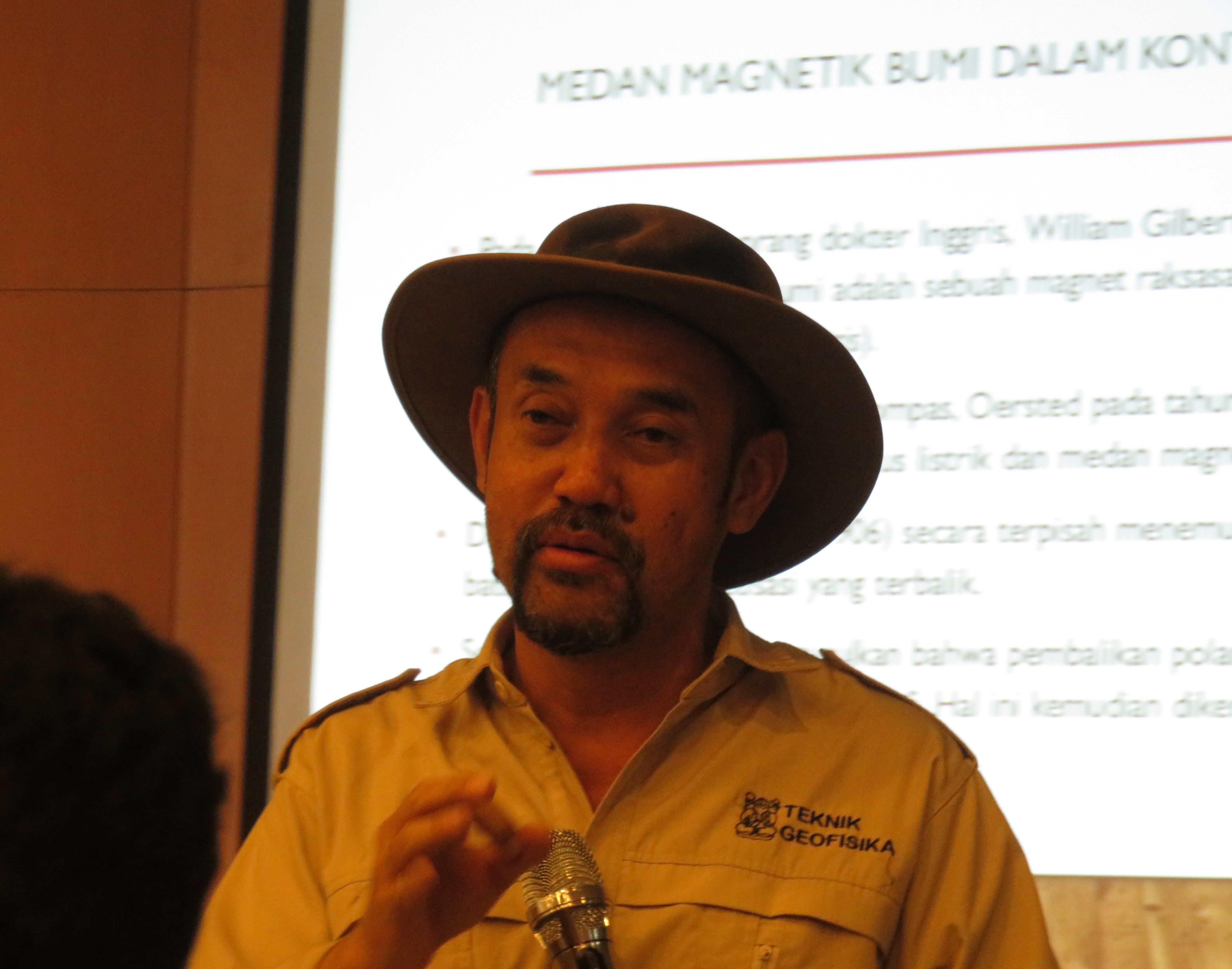ITB Professor’s Explanation on the Change on Earth’s Magnetic Field
By Adi Permana
Editor Adi Permana

*Discussion on changes on Earth’s magnetic field with Prof. Satria Bijaksana (Doc. Humas ITB)
BANDUNG, itb.ac.id – Earth’s Magnetic Field is not a static field. It is dynamic. However, based on a report from a Nature Journal issued on 9th January, Earth’s magnetic field movement happens fast, leaving Canada toward Siberia. Keeping that in mind, do we in Indonesia need to worry about the phenomenon?
This was discussed by Prof. Satria Bijaksana in a discussion themed “How Earth’s Magnetic Field Change and the Impact to Humankind” held by Global Geophysics Research Group, Faculty of Mining and Petroleum Engineering of ITB, on Wednesday (16/01/2019) at Energy Building Hall, ITB Campus.
According to Prof. Satria, what the researchers said on the journal reveals the result of their observation, which shows Earth’s magnetic fast movement. “That brings forward two concerns of the research. Practically, navigation maps should be updated immediately, and they should think about the cause of magnetic changes,” said Prof. Satria.
World Magnetic Model is used on all navigation systems. The model is updated once every five years. However, because magnetic field moves too fast, update is required even faster. However, updating maps fast will take long processes because it requires data from all over the world.
*Prof. Satria Bijaksana from Global Geophysics Research Group of ITB (Doc. Humas ITB)
“Variations regarding Earth’s magnetic field need to be known but not to be worried because Indonesia stands far away from magnetic poles and thus relatively unaffected,” he said. The biggest impact of magnetic field change will affect North Pole because navigation direction shifts.
A Glimpse at Magnetic Field
On the discussion, Prof. Satria explained that Earth’s magnetic field has been around for at least 4.2 billion years ago. Earth’s magnetic field is beneficial in determining direction on compass/navigation. In Indonesia, the first measure to Earth’s magnetic field intensity was conducted by de Rossell on 9 October 1792 in Surabaya.
“Earth’s magnetic field is basically very weak, undetectable with human sense. Basically it has dipole shape with two poles referred to as north pole and south pole. Direction and intensity of the field varies, depending usually on latitude position,” he said.
Currently, Earth’s magnetic field is weakening. But it is highly probable to strengthen again. “The trend is currently weakening, but do not worry because it is a common weakening. Seen from the track record, it used to weaken and strengthen,” he said.
The magnetic field is generated by electric current, caused by the movement of conductive material on the outer layer of Earth’s core. The Earth becomes a giant electromagnetic generator. This is commonly referred to as Dynamo Theory. Even though it is simple principally, details such as the property, material on the outer core, fluid movement mechanism, etc remain uncertain.
Prof. Satria said that, historically, Earth’s magnetic field has never reach nil. However, magnetic field reverse used to happen. The trigger could be meteor collision, the fall of continental plate onto the mantle, or the presence of new mental plume on the boundary between Earth’s core and mantle.
He explained how Earth’s magnetic field has several interesting aspects, such as how Earth’s magnetic field does not coincide with the axis of Earth’s rotation, not even passing Earth’s center. Earth’s Magnetic field is still measurable for 7 up to 10 times Earth’s diameter. Hence, satellite on outer space could still be controlled using Earth’s magnetic field.
Magnetic Field and Solar Wind
Earth’s magnetic field protects the Earth from solar wind, an activity where the Sun generates radiation of particles, which contains mostly of hot protons and high-energy from the Sun. According to Prof Satria, this should be a concern.
Magnetic field layer that covers the Earth is called magnetosphere. There are several conditions that occur to magnetosphere when interacting with solar wind. If the solar wind is weak, the magnetosphere expands, and when solar wind strengthens, the magnetosphere shrinks. The period when solar wind’s intensity rise is called geomagnetic storm. The storm could occur during coronal mass ejection (CME) eruption on the Sun which release shockwaves onto the solar system.
This magnetic storm could cause disturbances such as telegraph network interference in 1859, Electricity network outage in Canada in 1989, disturbance to one third of NASA’s satellite in 2003. “With our dependence to satellite telecommunication and communication, we have to realize that there may be interference due to interaction of the Earth’s magnetic field with solar wind,” he said.


.jpg)
.jpg)


.jpg)



